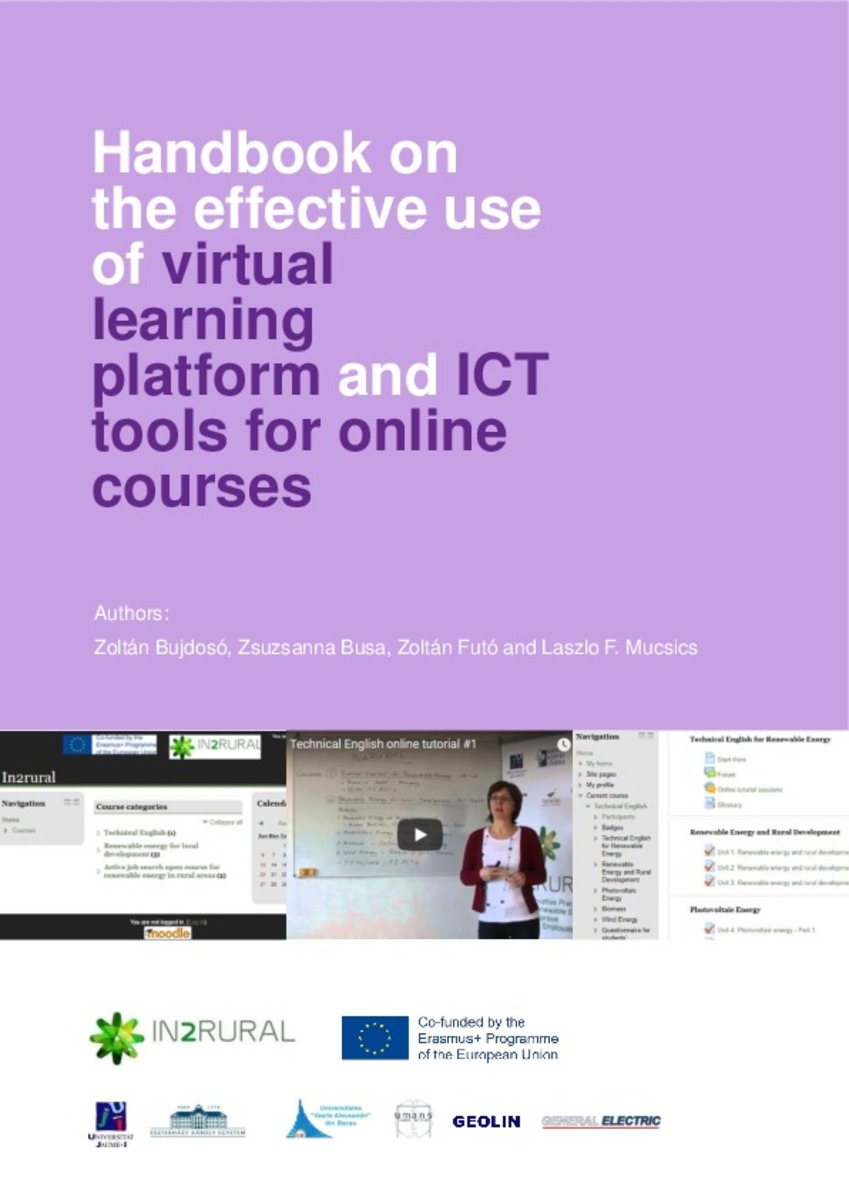Mostra el registre parcial de l'element
Handbook on the effective use of virtual learning platform and ICT tools for online courses
| dc.contributor.author | Bujdosó, Zoltán | |
| dc.contributor.author | Busa, Zsuzsanna | |
| dc.contributor.author | Futó, Zoltán | |
| dc.contributor.author | Mucsics, Laszlo F. | |
| dc.date.accessioned | 2017-09-26T11:11:33Z | |
| dc.date.available | 2017-09-26T11:11:33Z | |
| dc.date.issued | 2016 | |
| dc.identifier.uri | http://hdl.handle.net/10234/168970 | |
| dc.description.abstract | One of the major aims of IN2RURAL Erasmus+ Strategic Partnerships project is to develop online learning courses with high-level interactive online and offline educational material particularly for higher education students who intend to obtain specific information on renewable energy resources. There will be two different types of online course developed during the project. One of the courses is called “Technical English for renewable energy” (IO8) course, providing a base for the online course of “Renewable energy for local development” (IO9) with professional and academic content consisting of four modules: renewable energy and rural development module, photovoltaic module, biomass module and wind energy module. The compiled materials will include information about delivering online learning materials to students by means of assessments and tracking, collaboration and communication tools by delivering them with a high degree of practical information. The elaboration of each section within the “Renewable energy for local development” course has been divided between the participating project partners. The Spanish lead partner is responsible for the elaboration of the renewable energy and rural development module along with the photovoltaic module, while the Hungarian partners have created the biomass module and the wind energy section has been developed by the participating Romanian organisations. Both online courses and all four modules within “Renewable energy for local development” course follow a homogeneous structure. One of the main purposes of the handbook is to provide useful information for teachers on how to plan and prepare online educational material by defining the common elements that the course material of each module should include, providing a short documentation on how the sample files have to be prepared and then uploaded to the online learning platform. It also provides instructions with orientation purposes and samples to teachers on how to prepare the suitable framework for a learning material. Besides the e-learning material, the online courses also involve self-introductions of students and topic discussion forums, a glossary for each renewable energy resource module and additional extra materials, such as photos, presentations and extra bibliography. The “Technical English for Renewable Energy” course will contain a glossary providing students with the specific words and expressions, allowing them to follow the modules of the “Renewable energy for local development” online course. The online course provides opportunities both for individual and/or group discussion work, and the present handbook will guide the user how to become acquainted with the effective uses of virtual learning platform and ICTs along with some teaching methods to convey learning information. One of the main reasons for providing e-learning material through an electronic website is to promote interactivity among future students. These days, both teachers and students must rely on interactive learning materials besides the traditional printed texts during their professional work. ICT-based education has undoubtedly affected and is affecting the learning process of students and it is important to underline that a good ICT-based education has the potential to increase students’ motivation towards acquiring the required knowledge. Furthermore, it can be declared that ICT-based education undoubtedly helps to promote in connecting school experiences with work practices. In sum, the principal aims of the present “Handbook on the effective use of virtual learning platform and ICT tools for online courses” is to provide practical guidelines for teachers on how to provide learning material in ~.doc and ~.xls sample files that will be later transformed as an output into interactive and enjoyable electronic learning material, specifications for each parts of the learning platform, so that all the teachers working in different modules have a clear idea of the material they have to prepare for the course, a standardized evaluation for the modules. | ca_CA |
| dc.format.extent | 75 p. | ca_CA |
| dc.format.mimetype | application/pdf | ca_CA |
| dc.language.iso | eng | ca_CA |
| dc.publisher | Eszterházy Károly University | ca_CA |
| dc.rights | Atribución-NoComercial-CompartirIgual 4.0 Internacional | * |
| dc.rights.uri | http://creativecommons.org/licenses/by-nc-sa/4.0/ | * |
| dc.subject | local development | ca_CA |
| dc.subject | rural development | ca_CA |
| dc.subject | renewable energies | ca_CA |
| dc.subject | virtual learning | ca_CA |
| dc.subject | ICT | ca_CA |
| dc.title | Handbook on the effective use of virtual learning platform and ICT tools for online courses | ca_CA |
| dc.type | info:eu-repo/semantics/book | ca_CA |
| dc.identifier.doi | http://dx.doi.org/10.6035/IN2RURAL.2016.07 | |
| dc.rights.accessRights | info:eu-repo/semantics/openAccess | ca_CA |
| dc.relation.publisherVersion | http://in2rural.uji.es/ | ca_CA |
| dc.type.version | info:eu-repo/semantics/publishedVersion | ca_CA |








